Radipole Lake, Dorset, 21st November 2012
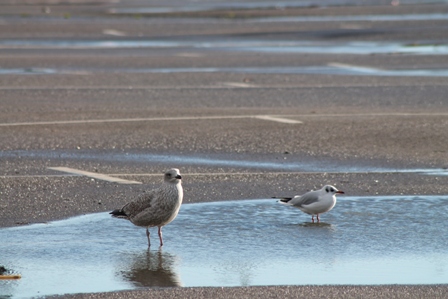
Herring Gull (left) and Black-headed Gull, Radipole Lake, Dorset, 21/11/12 (Dominic Couzens)
Gulls in sunshine – who can resist them? Well, it turns out, a lot of people can. The girl in the Visitor Centre said “Gulls are awesome…but difficult.” And that is the crux of their unpopularity, at least with birders. This post is to persuade you that they aren’t that bad.
Easy Lesson 1: Which is the larger gull in the above photograph, the Herring Gull on the left or the Black-headed Gull on the right? Have a long look. Got it?
Moral of the lesson – large gulls are much bigger than smaller gulls, and you are never going to confuse a Herring Gull (large) with a Black-headed Gull (small).
Easy Lesson 2: It’s very easy to age Black-headed Gulls.
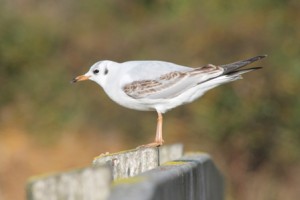
1st Winter Black-headed Gull, Radipole Lake, Dorset, 21/11/12 (Dominic Couzens)
This gull has brown on its wings. That’s a sure sign that it isn’t an adult. And since it’s now November, and wintertime, this bird has to be a First Winter, because this time next year it will be an adult, and look like the bird below.
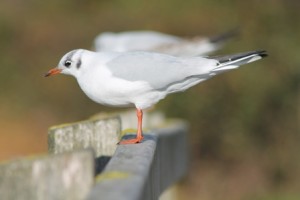
Adult Winter Black-headed Gull, Radipole Lake, Dorset, 21/11/12 (Dominic Couzens)
This gull (below) has no brown on its wings, so it’s an adult. And since it’s now winter, this bird is an adult winter Black-headed Gull. And you can tell it’s a Black-headed by the discrete dark spot behind its eye, as well as by the reddish legs and bill. In contrast to our other abundant gulls, it doesn’t have particularly obvious white spots on its black wing-tip, either.
Ready for something very slightly trickier?
Easy(ish) lesson 3: Which small to medium-sized gull has white wing-tips? It’s the (adult winter) Mediterranean Gull, a staple of Radipole’s car park. The flying bird
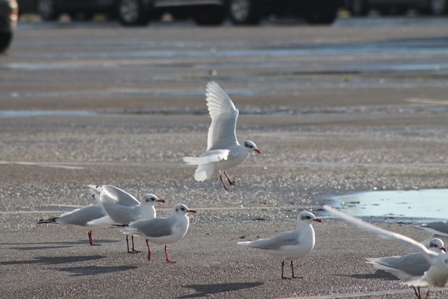
Mediterranean Gull, Radipole Lake, Dorset, 21/11/12 (Dominic Couzens)
here is pretty obvious, almost Little Egret-like in its whiteness of wing-tip. However, note that the bird beneath it to the right also has white wing-tips (as does the bird far right). Meanwhile, the bird beneath it to the left is a Black-headed Gull, (third from left overall) with black on its wing-tips. Easy enough, huh?
Now let’s have a closer look at the group on the ground (below). The bird on the right is clearly a Mediterranean Gull. Aside from the white wing-tips you can clearly see the large
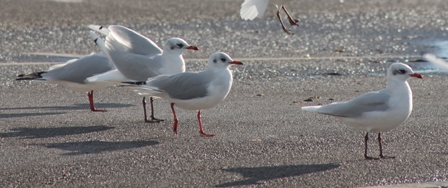
Mediterranean and Black-headed Gulls, Radipole Lake, Dorset, 21/11/12 (Dominic Couzens)
“bruise” around the eye, quite different and more extensive than the spot on the Black-headed Gull’s head (centre). Note, too, that it has a obviously thicker bill of a deeper red colour than the Black-headed, and that it is also paler grey.
Tricker is the bird in the photo below. Everything about it screams “Mediterranean Gull”
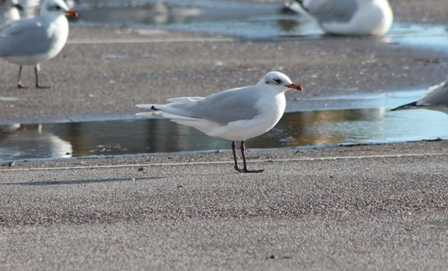
Second Winter Mediterranean Gull, Radipole Lake, Dorset, 21/11/12 (Dominic Couzens)
(the bruise on the head, the thick blobby bill, the white wing-tips and the long, very dark red legs). But what’s that dark mark on the wing just before the tip? That is what makes this an immature Mediterranean, actually a Second Winter Mediterranean. If you look carefully at the four gulls in them photo further up, you’ll see the same bird with its wings partly open second from left. Most Second Winter birds have more markings than this, a series of black “commas”.
Oh dear, has it got a bit complicated?

Can you do non adult yellow-legged and herring gull next please?
This is very clear and helpful, thank you. I am almost moved to come on a gulls galore trip!
Thank you. Brilliant. I hope you’ve written more stuff …
oh wow … a feast of stuff!!
As per Andrew above, I now can’t wait to go out and find some gulls. Apart from black-headed, herring and lesser-black backed I really have (had) no way of differentiating the species.
Thanks to your little guide, I feel more confident. The simple things for simple folk! Thank you.
I live in West Yorkshire not far from Fairburn Ings RSPB reserve. Recently I have noticed several groups of large white seagulls but with all black under wings
I estimate them to have at least a 4 foot wingspan and fly in groups of four to twenty individualsat a couple of hundred feet.
I cannot identify them in any of my books, can you help, please
I live in Lisburn, N. Ireland. I saw two large black backed gulls resting on a neighbour’s roof and would like to know if this is a normal sighting at this time of year?
Easy from side view – not so when they fly over you!